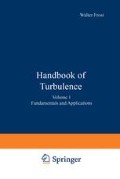Abstract
The statistical correlations described in the preceding chapter are useful in turbulence analyses and are relatively easy to measure. However, another powerful tool for describing turbulence is the method of spectral analysis. The spectral theory and the correlation theory are intimately connected mathematically with one another by the Fourier transformation. There is no additional information contained in the spectra that is not already contained in the correlations, but the two methods of description put different emphases on different aspects of the problem. For example, we discussed earlier the concept of energy transfer between different scales or orders of eddies. Spectral analysis allows us to describe the exchange of kinetic energy associated with different eddy sizes or with different fluctuation frequencies occurring in the turbulence.
Access this chapter
Tax calculation will be finalised at checkout
Purchases are for personal use only
Preview
Unable to display preview. Download preview PDF.
References
Churchill, R. V., Fourier Series and Boundary Value Problems, McGraw-Hill Book Co., New York (1941).
Yaglom, A. M., An Introduction to the Theory of Stationary Random Functions, translated and edited by R. A. Silverman, Prentice-Hall Inc., New Jersey (1962).
Taylor, A. E., Advanced Calculus, Ginn and Company, New York (1955).
Gnedenko, B. V., The Theory of Probability, translated by B. D. Sickler, Chelsea Publishing Co., New York (1962).
Reynolds, A. J., Turbulent Flows in Engineering, John Wiley and Sons, New York (1974).
Batchelor, G. K., Homogeneous Turbulence, Cambridge University Press, London (1967).
Hinze, J. O., Turbulence, McGraw-Hill Book Co., New York (1957).
Tennekes, H., and J. L. Lumley, A First Course in Turbulence, MIT Press, Cambridge, Massachusetts (1972).
Panchev, S., Random Functions and Turbulence, Pergamon Press, Oxford, England (1971).
Author information
Authors and Affiliations
Editor information
Editors and Affiliations
Rights and permissions
Copyright information
© 1977 Plenum Press, New York
About this chapter
Cite this chapter
Frost, W. (1977). Spectral Theory of Turbulence. In: Frost, W., Moulden, T.H. (eds) Handbook of Turbulence. Springer, Boston, MA. https://doi.org/10.1007/978-1-4684-2322-8_4
Download citation
DOI: https://doi.org/10.1007/978-1-4684-2322-8_4
Publisher Name: Springer, Boston, MA
Print ISBN: 978-1-4684-2324-2
Online ISBN: 978-1-4684-2322-8
eBook Packages: Springer Book Archive

